Imagine logging in and seeing all your document data already extracted, verified, and ready to use. No clutter. No manual entry. Just clean, actionable information at your fingertips. That’s not some distant dream; it’s what the best intelligent document processing software makes possible today.
More and more companies are realizing the value of intelligent document processing (IDP). It’s become a core part of digital transformation strategies worldwide. And if you're on the hunt for the a document automation tool for your organization, you've landed in the right place. We’ll guide you through how IDP works, common challenges (and how to solve them), and the top 10 IDP platforms in 2025.
Why You Need the Best Intelligent Document Processing Software Right Now
Companies see a return on investment of 30–200% in their first year of implementing IDP.
The global IDP market is booming. It was valued at around $1.5 billion in 2023 and is projected to surpass $11.4 billion by 2030, growing at a CAGR of ~34%. That kind of growth isn’t just talk. It’s backed by real results. Studies show companies see a return on investment of 30–200% in their first year of implementing IDP. And in financial services, over 52% of firms report saving more than $100,000 annually through document automation.
What’s fueling this? The reality is that over 90% of business documents, contracts, emails, invoices, and forms are unstructured. Traditional OCR and RPA tools struggle with these formats. That’s where the best intelligent document processing software stands apart: it turns unstructured chaos into structured clarity.
The Science Behind the Best Intelligent Document Processing Software: How It Works
An advanced IDP system doesn’t just extract text. It mimics how a human would understand a document, only faster, more consistently, and at scale. Here’s what a typical IDP pipeline looks like:
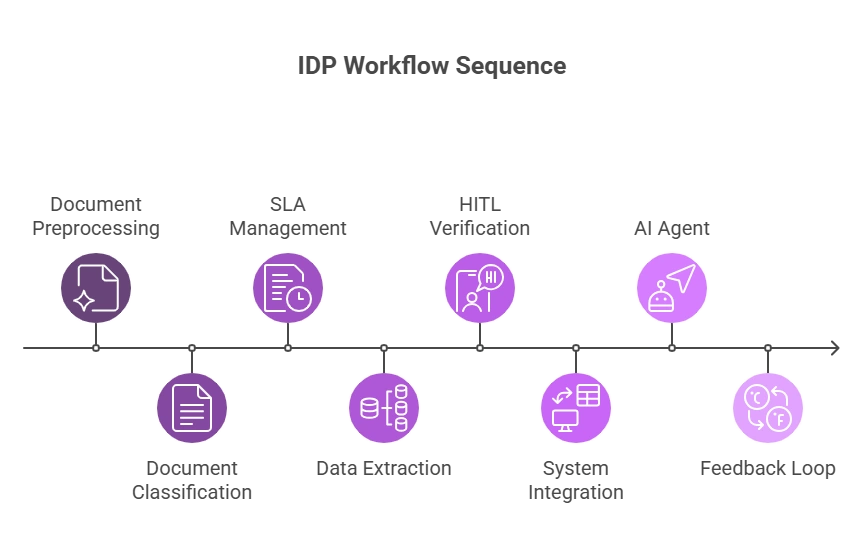
- Document Pre-processing: Cleans up documents through image enhancements like de-skewing, noise reduction, and contrast adjustments to ensure accurate extraction.
- Document Classification: Automatically identifies the type of document (e.g., invoice, contract, application form) using AI models, even in multiple languages or mixed formats.
- SLA Management: Documents are prioritized based on urgency, so time-sensitive files are handled first without manual triage.
- Data Extraction: Uses a blend of IDP, Agentic AI, and machine learning to pull structured data, text, tables, line items, and images, even from noisy or inconsistent layouts.
- Human-in-the-Loop (HITL) Verification: When the system flags uncertainties, human reviewers validate and correct the data, ensuring 100% reliability.
- System Integration: Final data is routed into your ERP, CRM, or business applications with zero manual effort.
- AI Agent: AI Agent solution goes beyond data extraction by automating follow-up tasks like generating reports and running analytics.
- Feedback Loop: Every correction improves the model, so your IDP system keeps getting smarter over time.
Common Roadblocks When Deploying IDP (and How to Get Past Them)
Even the top-rated document processing solutions can run into challenges during implementation. Here are a few, and how to avoid them:
- Data Security: Choose vendors with strong encryption and industry-standard certifications like SOC 2 or ISO 27001. Internally, restrict access to sensitive documents.
- Integration Pains: Legacy systems aren’t always plug-and-play. Prioritize platforms with robust APIs, and involve your IT team early for smooth integrations.
- User Resistance: Change is hard. Get early buy-in, identify internal champions, and clearly demonstrate how IDP makes work easier and faster for the team.
- Budget Approval: Use real numbers to make your case. If you’re paying $15 per invoice manually and IDP can bring it down significantly. Many vendors provide ROI calculators and real-world case studies to back this up.
The 10 Best Intelligent Document Processing Software Platforms of 2025
1. Infrrd – Built for Enterprise-Grade Document Intelligence
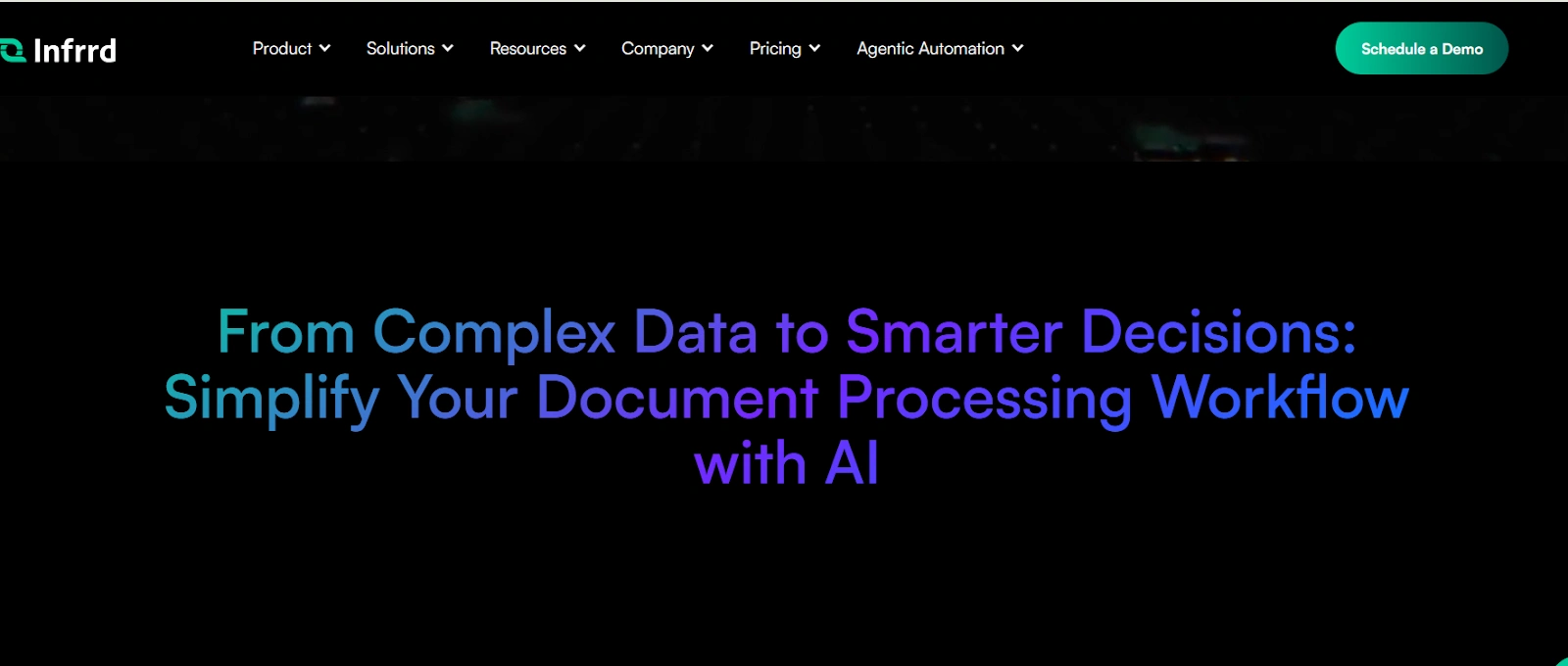
Infrrd’s Intelligent Document Processing (IDP) platform is designed to help enterprises manage the growing complexity of document workflows. Rather than relying on templated data extraction, which often break when document formats change, Infrrd uses pre-trained machine learning models that can understand layout, structure, and content across a wide variety of document types.
This makes it well-suited for organizations that work with unstructured or variable documents, including contracts, shipping documents, engineering drawings, forms, and more. It’s built to extract specific details, like tables, line items, totals, or custom fields, with a high degree of accuracy, even when the layout is inconsistent or the document is scanned.
The platform includes built-in support for SLA-based processing, validation workflows, audit trails, and exception handling via human-in-the-loop. It also integrates with major ERP and workflow systems, allowing teams to embed document automation into existing processes without major overhauls.
Pros:
- Template-Free Flexibility: Extracts data from any document type without needing predefined templates or layout rules.
- Understands Complex Layouts: Accurately reads multi-page documents, tables, and embedded fields—even across multi-line formats.
- Custom Logic Support: Easily adapts to your business rules, such as isolating freight costs or handling region-specific formats.
- Smart Exception Handling: Flags only the data that needs human review, reducing manual oversight.
- Built-In SLA Awareness: Automatically prioritizes and routes time-sensitive documents to meet your internal deadlines.
- Enterprise-Ready Integrations: Connects seamlessly with major platforms like SAP, Oracle, NetSuite, and Microsoft Dynamics.
- Speedy Implementation; Deploys in weeks, not months, so teams can start seeing results faster.
- Reliable at Scale: Maintains high data quality even when document types and volumes vary.
Considerations:
- Enterprise-Grade Focus: Best suited for mid-to-large enterprises with high document volumes and structured internal workflows.
Pricing:
- Standard IDP: Standard document processing for structured and semi-structured documents.
- No-Touch Processing (NTP) Fully automated No-Touch Processing with minimal manual intervention.
- AGP (Accuracy Guarantee Policy): Combines No-Touch processing and human-in-the-loop solutions so that the end user receives 100% accurate data.
- Custom Enterprise Solutions with Agentic AI: Tailored packages for high-volume or specialized use cases, with advanced Agentic AI capabilities, and integrations.
Pricing varies based on volume, document complexity, customization needs, and the level of agentic AI involved, making it easy for organizations to scale automation on their terms.
2. Alteryx: Best for Spreadsheet-Based Workflows

Alteryx is a leading analytics automation platform that focuses heavily on turning spreadsheet data into actionable insights. While not a traditional IDP solution in the OCR or document scanning sense, Alteryx excels at processing structured data, especially from Excel files, CSVs, and flat data tables. If your business deals with large volumes of spreadsheets and manual data blending tasks, Alteryx could be your best intelligent document processing software for automating, transforming, and analyzing that information at scale.
Alteryx enables users, especially data analysts and operations teams, to clean, blend, and enrich spreadsheet data without writing complex code. Its drag-and-drop interface is user-friendly, and it integrates well with databases, cloud storage, and BI tools. While it’s not designed to extract data from scanned PDFs or images, it’s a great fit for spreadsheet-heavy workflows that need speed, governance, and repeatability.
Pros:
- Purpose-built for data blending, cleansing, and analytics on spreadsheet-like documents
- Ideal for operational teams in finance, accounting, and data reporting roles
- Offers advanced automation, including predictive modeling and Python/R integration
- No-code/low-code interface makes it accessible to business users
- Strong integration with Excel, SQL databases, Snowflake, Tableau, and more
Cons:
- Not suitable for unstructured or scanned document types (e.g., invoices, contracts, forms)
- Lacks built-in OCR or handwriting recognition
- Primarily focuses on structured data rather than full-spectrum document processing
Pricing
Plans, including Professional and Enterprise Editions, are available via custom quotes. Professional subscriptions typically begin around $5,195–$5,000 per user per year, depending on seat count (usually a minimum of three users), and unlock advanced data sources, automated insights, AI Copilot, cloud reporting, and workflow automation.
3. Microsoft Power Automate (with AI Builder)

Microsoft Power Automate is a low-code automation tool within the Microsoft ecosystem. When paired with AI Builder and Azure Form Recognizer, it enables users to build basic document processing workflows.
Pros:
- Native integration with Office 365, SharePoint, and Dynamics
- Low-code interface for business users
- Good for standard documents like invoices, IDs, or receipts
Watch Out For:
- Lacks advanced exception handling or document understanding
- Custom model training is limited in scope
- Not ideal for high-volume, unstructured documents
It’s a good fit for Microsoft-centric teams, but may fall short as a scalable alternative for complex enterprise needs.
Pricing
- Premium (Per-User Plan): Approximately $15 per user per month, billed annually. This includes unlimited cloud flows, attended desktop (RPA) automation, premium connectors, 5,000 AI Builder service credits, process‑mining capabilities (50 MB storage), and Microsoft Dataverse entitlements (250 MB database, 2 GB file storage)
- Process (Per-Bot Plan): $150 per bot per month, billed annually. Designed for unattended automation, this includes cloud and desktop flows, AI Builder credits, and Dataverse storage (50 MB database, 200 MB file storage)
- Hosted Process: $215 per bot per month, adding Microsoft-hosted virtual machine infrastructure to the capabilities of the Process plan
4. Grooper – For Technical Power Users

Pros:
- Highly adaptable: Ideal for enterprises needing deep customization, Grooper supports complex rules and custom classifiers for precise extraction.
- Covers diverse formats: Handles everything from structured invoices to semi-structured contracts and handwritten forms.
- Strong image processing: Built-in preprocessing boosts extraction accuracy by cleaning up noisy or skewed documents.
- Scalable enterprise tool: Supports both cloud and on-prem deployments and integrates with CMS systems, databases, and business applications
Cons:
- Steeper learning curve: Powerful capabilities come with complexity—users often need training or technical know-how .
- Setup requirements: Implementation and optimization frequently require IT support or consulting services.
- Less turnkey than cloud tools: Compared to newer SaaS-based options, Grooper demands more effort and expertise to configure.
Pricing
Grooper doesn’t list its pricing online. To get accurate costs, you need to contact them directly. Some sites mention a $1/year starting price, but it could also be just a placeholder. The real price depends on things like how much you use it, which features you need, and any extra support or customization.
5. Workato – Workflow Automation
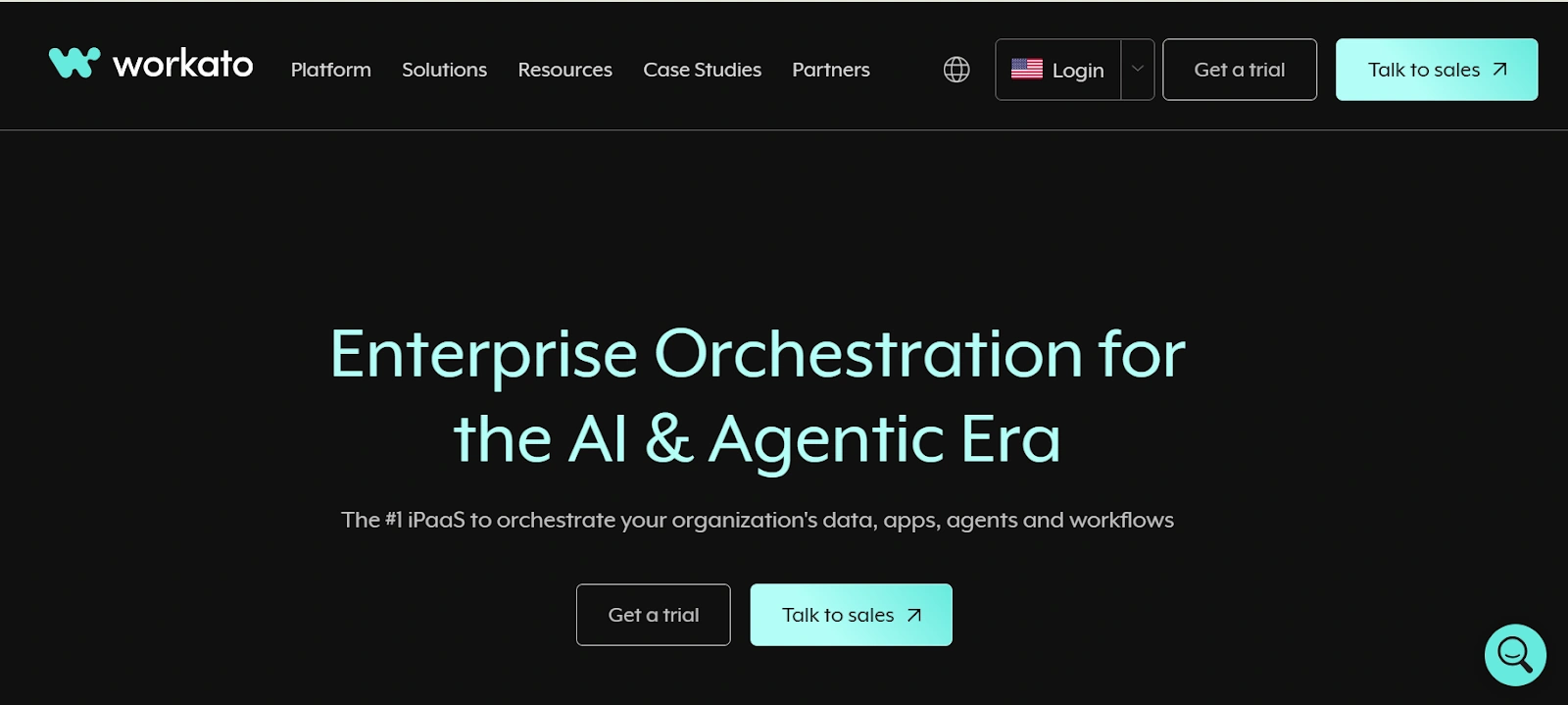
Workato is a popular iPaaS (Integration Platform as a Service) that also offers automation workflows with document processing capability via connectors.
Strengths:
- Strong integration with hundreds of SaaS apps
- Useful for triggering actions based on document metadata
Watch Out For:
- No built-in document intelligence or data extraction
- Requires pairing with external OCR tools or APIs
- Best used as a workflow trigger engine, not a document automation platform
Pricing
- Number of Connections: Pricing increases as you connect more apps and systems within your workflows.
- Type of Integration: Real-time or batch processing integrations may come with different pricing based on complexity.
- Workspace Setup: The way you configure user access, roles, and permissions in your Workato workspace can impact costs.
- Task Volume: For recipes that handle a high number of tasks, Workato offers High-Volume Recipes (HVR) with flat-rate pricing instead of charging per task.
6. Iron Mountain - Insight Intelligent Document Processing
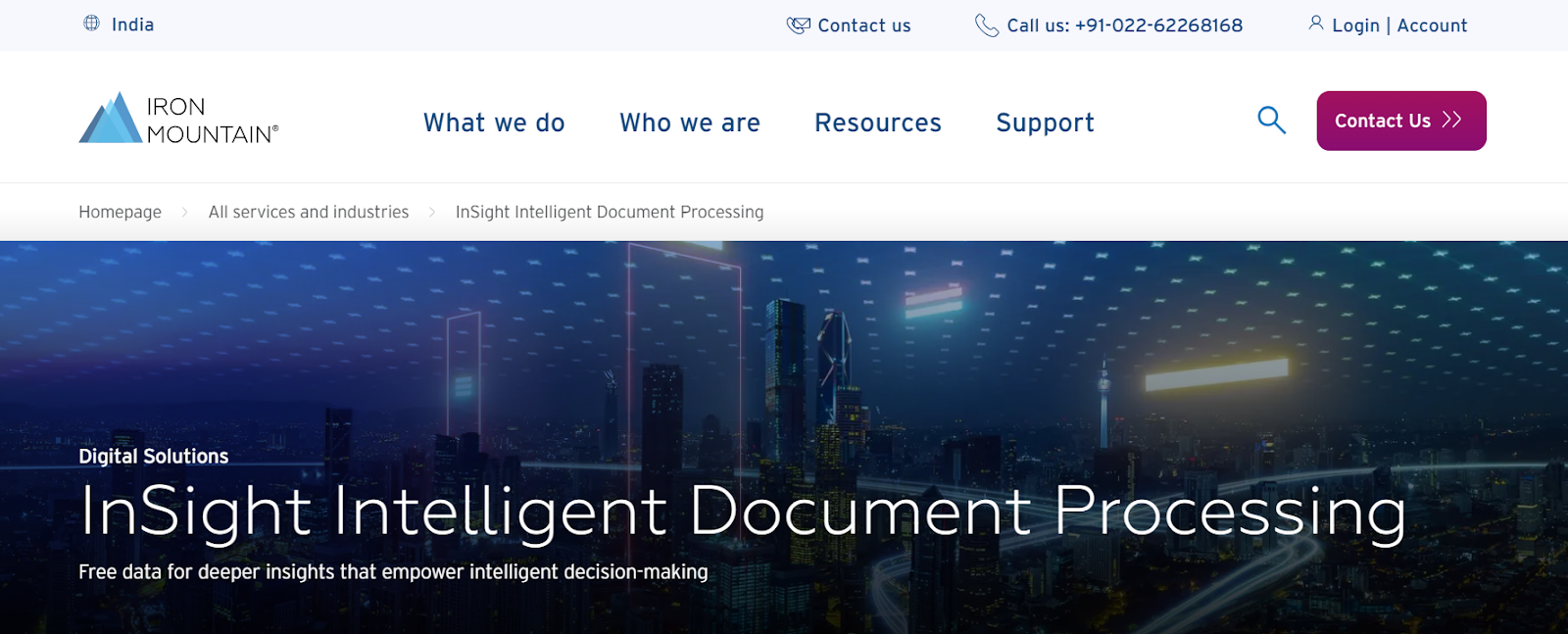
Iron Mountain offers an Intelligent Document Processing (IDP) solution through its InSight Digital Experience Platform (DXP). It’s designed to help companies automate invoice handling by capturing, extracting, and routing invoice data using AI.
What It Does Well:
- AI-Powered Data Extraction
- Workflow Automation
- ERP Integration
- Centralized Access
- Scalable & Cloud-Based
Points to Consider:
- Still New to the Market: Launched in late 2024, it has limited customer reviews and a shorter track record compared to mature players.
- Integration May Require IT Help: While APIs are available, connecting legacy systems could take time and technical support.
- Learning Curve: It's a feature-rich platform that may need training and support, especially for less technical users.
- Not an End-to-End AP Tool: The platform automates document handling but doesn’t manage payments—your ERP will still handle that.
- Support Experience May Vary: Some past reviews on Iron Mountain's other services point to inconsistent customer support, so it’s worth evaluating SLAs and onboarding help.
- Cloud-Only Deployment: There’s no clear on-prem option, which could be a hurdle for companies with strict data regulations.
Pricing
Iron Mountain offers different pricing solutions for different offerings such as:
Document Storage
- Offsite Storage: Tiered pricing based on document volume and contract length (1, 3, or 5 years).
- Storage Minimums: May include monthly minimums or volume thresholds.
- Handling & Transport: Additional fees for retrieval, delivery, and handling.
- Specialized Storage: Custom pricing for vault storage of sensitive/valuable items.
Secure Shredding
- On-Site Shredding: Mobile shredding at your location.
- Off-Site Shredding: Documents are shredded at secure Iron Mountain facilities.
- Recurring Plans: Charged per bin/console and pickup frequency.
- One-Time Projects: Priced per box or per pound for bulk jobs.
Digital Solutions
- Document Scanning: Priced by number of pages or volume scanned.
- Cloud Storage: Billed per GB with potential access/transfer fees.
- Digital Management Tools: Subscription-based pricing for records and policy management.
7. AirSlate – Digital Forms Automation

AirSlate focuses on automating business documents and digital forms with ease. It offers intuitive drag-and-drop tools that make it simple to build workflows without writing a single line of code. While it’s not built for deep document intelligence, it’s a great tool for teams looking to digitize structured, front-office paperwork.
As one of the more niche entries in the space, AirSlate supports digital form creation—but it doesn’t quite meet the bar for the best intelligent document processing software. It’s ideal for streamlining form-based processes but falls short when it comes to handling scanned files, unstructured content, or documents that require AI-powered understanding.
Strengths:
- Great for digitizing paper-based forms
- Easy-to-use, no-code workflow builder
- Ideal for HR, admin, or front-office documentation
Watch Outs:
- Doesn’t handle scanned or image-based documents
- Lacks AI-driven document understanding
- Not suited for backend workflows or complex automation
Pricing
Free Plan: $0 per month, includes 10 credits for basic usage, standard bots and integrations, and access to online support; unlimited users allowed.
Growth Plan: ~$399 /month (billed annually), includes 10,000 credits per year, email and chat support, plus one free Zoom session with a solutions consultant.
Automate 360 Plan: ~$799 /month (billed annually), includes 20,000 credits per year, API access, one premium integration, priority Zoom support, and a premium SLA.
Enterprise Plan: Custom quoted — includes all Automate 360 features plus custom integrations, deployment support, SSO, granular access control, enterprise reporting, and monitoring
8. Ephesoft (Now Moved to Kofax)

Ephesoft offers an open and extensible intelligent document processing platform, designed with developers and system integrators in mind. It provides robust capabilities for document classification and data extraction, along with flexible deployment options—making it a solid fit for organizations that prefer to customize their IDP workflows from the ground up.
As one of the best intelligent document processing software options for technically mature teams, Ephesoft stands out for its open APIs and hybrid deployment model. It can handle a wide variety of document formats and integrates well with existing automation ecosystems. However, it does require a fair amount of IT involvement to configure and maintain.
Strengths:
- Fully open APIs and highly customizable workflows
- Supports both cloud and on-prem deployments
- Strong focus on core IDP functionality
- Works across multiple document types and sources
Watch Outs:
- High dependence on IT and professional services
- User interface is less intuitive for non-technical users
- Ongoing maintenance and updates can be resource-heavy
Pricing
Ephesoft offers subscription-based pricing that varies depending on the features selected and the length of the contract. While some listings show a starting price as low as $0.01 per year, this is generally seen as a placeholder rather than a realistic cost. Actual pricing is typically structured on a “per feature, per year” basis, tailored to the organization’s specific use case. Ephesoft supports businesses of all sizes and offers products like Semantik for Invoices and Cloud HyperExtender for more advanced needs.
9. Tungsten Automation
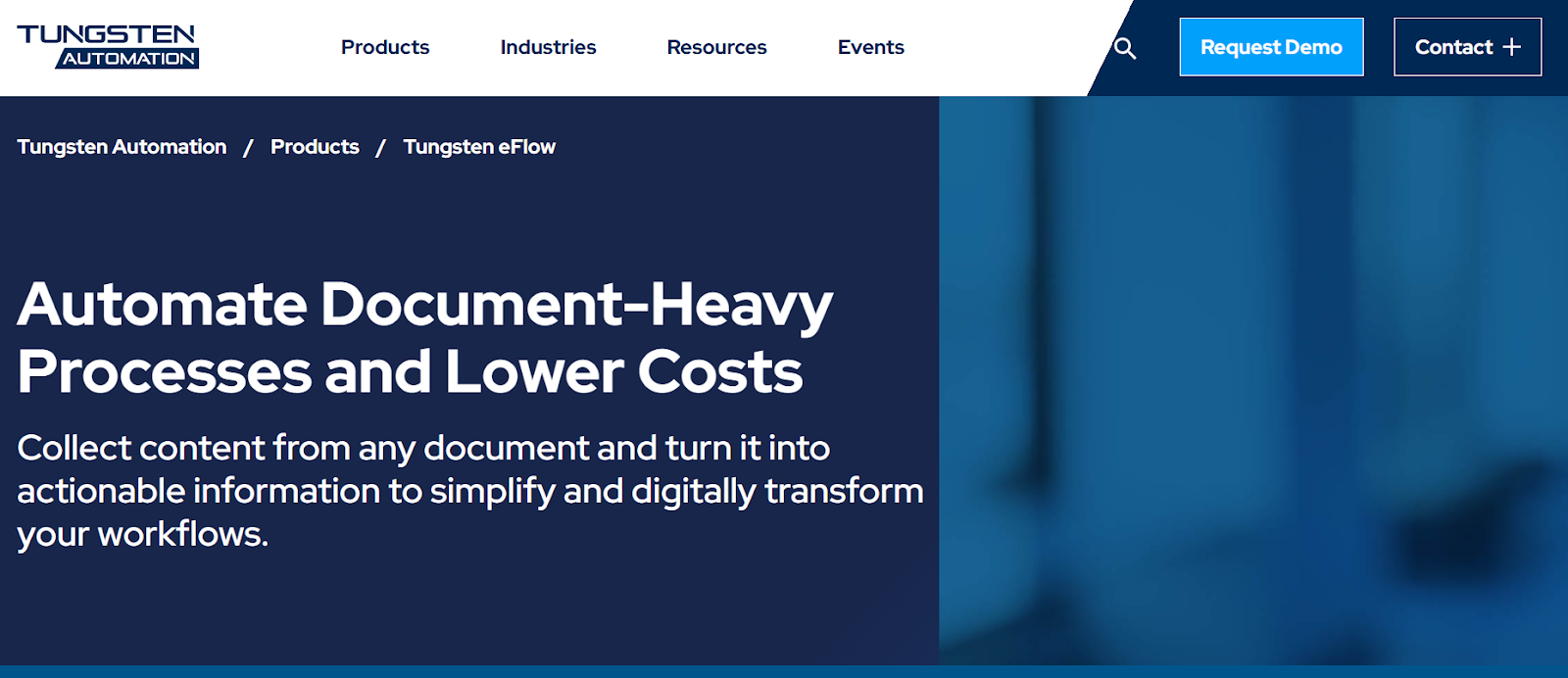
Top Image Systems (TIS) eFLOW, now part of the Tungsten Automation portfolio, is a longstanding player in the document processing space, particularly well-established in Europe. Known for its deep experience in document capture and imaging, eFLOW offers strong integration capabilities with major ERP systems like SAP, Oracle, and Microsoft Dynamics.
The platform includes AI-assisted trend analysis features and is designed to support complex document workflows. However, it comes with notable trade-offs that teams should consider.
Pros:
- Strong ERP integrations (SAP, Oracle, Dynamics)
- AI-supported data analysis and document trend detection
- Deep experience in high-volume document capture and processing
Cons:
- Legacy architecture with limited modern AI capabilities
- Complex setup that often requires IT involvement and coding expertise
- Steep learning curve, especially for non-technical users
- Interface and user experience feel dated compared to newer SaaS platforms
- Licensing can be expensive for the level of flexibility offered
Pricing
Tungsten Automation has a separate pricing plan for businesses. The Power PDF Advanced for Windows plan is ideal for small businesses and teams, priced at ₹12,199 for a one-time, perpetual desktop license, with no recurring subscription fees. It includes features like e-signatures, redaction, batch processing, and password protection, and is compatible with Windows 8.1, 10, and 11 (both 32 & 64-bit).
10. Nanonets
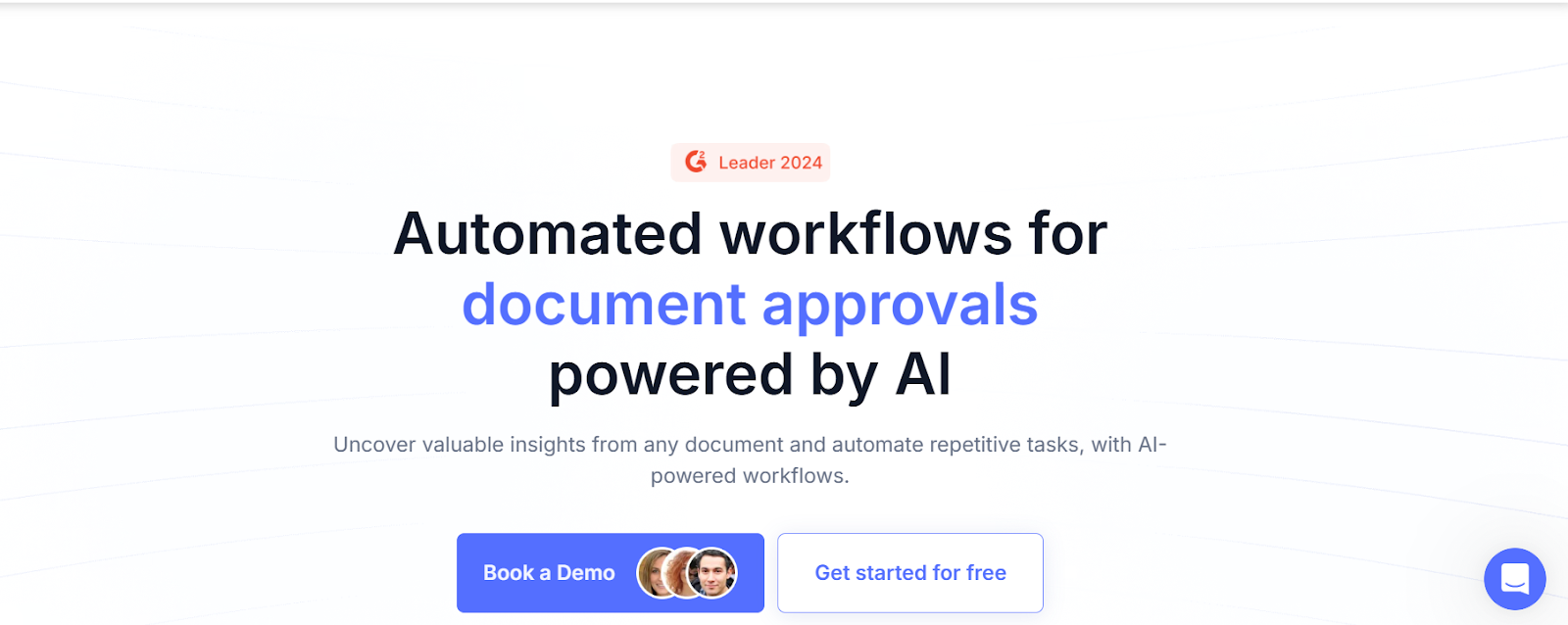
Nanonets is a lightweight document processing tool built for fast deployment and ease of use. It comes with pre-trained AI models that work well for basic document types like forms, receipts, and short structured layouts. Its simplicity makes it a good starting point for teams looking to dip their toes into automation without a steep learning curve.
While Nanonets offers a user-friendly experience, it doesn't quite meet the mark for the best intelligent document processing software when it comes to scalability or complexity. It's more suited for low-volume use cases where documents follow consistent formats.
Strengths:
- Quick onboarding and easy setup
- Good performance on simple forms and receipts
- Minimal training is needed to get started
Watch Outs:
- Struggles with complex, lengthy, or high-variance documents
- Accuracy often depends on user-defined training data
- Not built for enterprise-scale or highly regulated workflows
Pricing
Nanonets offers a flexible, usage-based pricing structure across 2 main plans to accommodate individual users, teams, and enterprises:
- Starter (Pay-As-You-Go):
No monthly fee. The first 500 pages are free, then $0.30 per page. Supports unlimited fields and basic table capture. Workflow step integrations are billed at approximately $0.05 per run. Ideal for small teams - Pro (Fixed Monthly):
Approximately $999/month, which covers up to 10,000 pages. Additional pages billed at $0.10 each. Includes up to 20 data fields, collaboration features, annotation services, custom AI capture, and team workflow integrations.
In a Nutshell: Choosing the Best Intelligent Document Processing Software for Your Business
Not all IDP solutions are built the same. Some excel at workflow automation, while others prioritize AI-powered document intelligence. The best intelligent document processing solution for your business depends on factors like the complexity of your documents, your current tech stack, and the resources your team can commit.
Each platform highlighted in this list brings its own strengths to the table. What works well for one organization might not be the right fit for another. That’s why it’s important to evaluate your document types, integration needs, and long-term automation goals before making a decision.
Ultimately, the best intelligent document processing solution is the one that fits your business today—and scales effortlessly as your needs grow.
→ Curious to see what that looks like for you? Book a demo and explore your options.
FAQs
A pre-fund QC checklist is helpful because it ensures that a mortgage loan meets all regulatory and internal requirements before funding. Catching errors, inconsistencies, or compliance issues early reduces the risk of loan defects, fraud, and potential legal problems. This proactive approach enhances loan quality, minimizes costly delays, and improves investor confidence.
A pre-fund QC checklist is a set of guidelines and criteria used to review and verify the accuracy, compliance, and completeness of a mortgage loan before funds are disbursed. It ensures that the loan meets regulatory requirements and internal standards, reducing the risk of errors and fraud.
Using AI for pre-fund QC audits offers the advantage of quickly verifying that loans meet all regulatory and internal guidelines without any errors. AI enhances accuracy, reduces the risk of errors or fraud, reduces the audit time by half, and streamlines the review process, ensuring compliance before disbursing funds.
Choose software that offers advanced automation technology for efficient audits, strong compliance features, customizable audit trails, and real-time reporting. Ensure it integrates well with your existing systems and offers scalability, reliable customer support, and positive user reviews.
Audit Quality Control (QC) is crucial for mortgage companies to ensure regulatory compliance, reduce risks, and maintain investor confidence. It helps identify and correct errors, fraud, or discrepancies, preventing legal issues and defaults. QC also boosts operational efficiency by uncovering inefficiencies and enhancing overall loan quality.
Mortgage review/audit QC software is a collective term for tools designed to automate and streamline the process of evaluating loans. It helps financial institutions assess the quality, compliance, and risk of loans by analyzing loan data, documents, and borrower information. This software ensures that loans meet regulatory standards, reduces the risk of errors, and speeds up the review process, making it more efficient and accurate.








